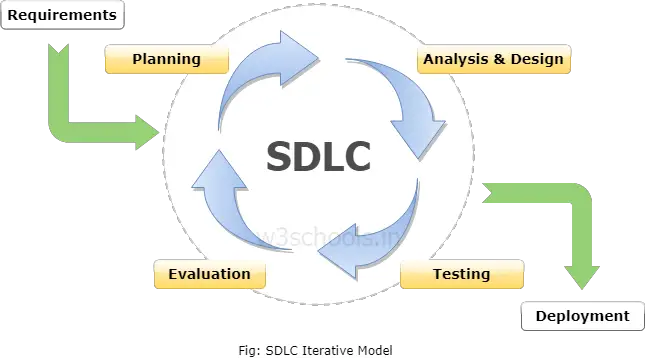Software Development Life Cycle (SDLC) is extremely vast and full of various development and testing activities, methodologies, techniques, tools, and more. It engages strong planning as well as management, computation, plan, and preparation. After completing all the cycles and iterations as per requirements, the application gets developed successfully. This model is also a division of SDLC (Software Development Life Cycle). In this chapter, you will learn about this model in details.
What is SDLC Iterative Model?
The popular iterative model gives an exact performance of the development of software as a life cycle. It primarily focuses on preliminary growth and design and then gains momentum slowly with more complexity as well as meet requirements until the final software is built entirely. So, basically, the iterative development model is an approach of segmenting any large software development process into smaller portions.
This type of SDLC model does not target to establish a complete specification plan. As an alternative, this model is dedicatedly designed to start with minimum requirements specifying as well as implementing only a part of the software. The prototype is then further reviewed for additional requirements. The practice then takes an iterative form to create a new version of the application.
Phases of Iterative Model
The iterative life cycle model comprises repeating the below-mentioned four stages as a sequence. These are:
- Requirements Phase: In the requirements phase of software development, the system related information is gathered and analyzed. The collected requirements are then planned accordingly for developing the system.
- Design Phase: In the Design phase, the software solution is prepared to meet the necessities for the design. The system design may be a new one or the extension of a previous build one.
- Implementation and Test: In the implementation as well as a test phase, the system is developed by coding and building the user interface and modules which is then incorporated and tested.
- Review Phase: The review phase is where the software is estimated and checked as per the current requirement. Then, further requirements are reviewed discussed and reviewed to propose for an update in the next iteration.
At every stage and cycle of this model, the decision is taken if the system created by the iteration or cycle will be rejected or not, or needs to process further for next cycle which is technically termed as incremental prototyping. Ultimately a situation will come, in which by implementing this model, the system requirements get complete & then the software can be distributed or delivered to the customer.
Graphical Presentation of the SDLC Iterative Model

Scenarios Where the Iterative Model Can Be Used
Iterative model is used in the following purposes:
- Here, the system requirements can be classified and understood.
- Primary necessities of the system can be defined; at the same time, some system's working can be improved with the development process.
- If a new technology needs prior understanding, this model can be helpful to know the latest technology and increment or update the model accordingly.
- This model is also useful when there are high risks in the system characteristic and goals.
- Situations where resources with required skill sets are not accessible, and the system needs to be developed on a contract basis, choosing this model is a suitable decision.
Benefits of Using Iterative Model
- Produces working system rapidly and before time throughout the software development life cycle
- Provides more and more flexible and enhance based on requirements.
- Simple to test as well as repair as small iteration.